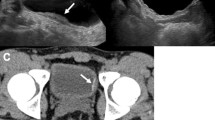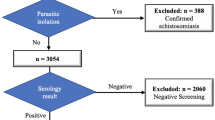Abstract
Ultrasonographic evaluation of 213 patients with urinary schistosomiasis in different age groups was performed in an endemic area of the Democratic Republic of Congo. The results were compared with 94 age matched controls without urinary schistosomiasis. In patients the bladder showed thickening of the wall, polypoid lesions of the mucosa and bladder wall, calcifications and urinary retention. Urinary tract obstruction, predominantly unilateral, was demonstrated. The lesions increased in severity with the intensity of infection, parallel to an increase in ova excretion. Children aged between 8 and 19 years were most severely affected. Pathological lesions of the upper urinary tract were rare in patients over 25 years of age. The combination of morphological abnormalities was interpreted as being specific for urinary schistosomiasis as they did not occur in the control group. It is suggested that real time ultrasonography may be used to identifiy morphological lesions in urinary schistosomiasis.
Similar content being viewed by others
References
Abdel-Salam E, Ehsan A (1978) Cystoscopic picture of Schistosoma haematobium in Egyptian children correlated to intensity of infection and morbidity. Am J Trop Med Hyg 27: 774
Afifi MA (1934) Roentgenographic manifestations of urinary bilharziasis and calculous formations in Egypt, and intravenous pyelography. Am J Roentgenol 31: 208
Aisen AM, Gross BH, Glazer GM (1983) Computed tomography of ureterovesical schistosomiasis. J Comp Ass Tom 7: 161
Al Ghorab MM (1968) Radiological manifestations of genitourinary bilharziasis. Clin Radiol 19: 100
Atala A, Zaher MF (1969) Bilharzial calcification of the renal capsule: a case report. J Urol 101: 125
Bohrer SP, Lucas AO, Cockshott WP (1971) Roentgenographic features of schistosomiasis in children. Zeitschr Tropenmed Parasit 22: 177
Buchanan WM, Gelfand M (1970) Calcifications of the bladder in urinary schistosomiasis. Trans R Soc Trop Med Hyg 64: 593
Cheever AW, Kamel IA, Elwi AM, Mosimann JE, Danner R, Sippel JE (1978) Schistosoma mansoni and S. haematobium infections in Egypt. III. Extrahepatic pathology. Am J Trop Med Hyg 27: 55
Dietrich M, Kern P (1983) Tropenlabor: Diagnostik für die ärztliche Praxis mit einfacher Laborausrüstung. Fischer, Stuttgart, New York
Dinkel E, Dittrich M, Peters H, Alzen G, Walz P, Ney C, Schulte-Wissermann H, Weitzel D (1985) Sonographic biometry in obstructive uropathy of children: preoperative diagnosis and postoperative monitoring. Urol Radiol 7: 1
Doehring E, Feldmeier H, Daffalla A (1983) Day-to-day variation of egg excretion and circadian rhythm in urinary schistosomiasis in the Sudan. Ann Trop Med Parasitol 77: 587
Edington GM, Lichtenberg Fv, Nwabuebo I, Taylor JR, Smith JH (1970) Pathological effects of schistosomiasis in Ibadan, Western State of Nigeria I. Incidence and intensity of infection; distribution and severity of lesions. Am J Trop Med Hyg 19: 982
Ellenbogen PH, Scheible FW, Talner LB, Leopold GR (1978) Sensitivity of grey scale ultrasound in detecting urinary tract obstruction. AJR 130: 731
Farid Z, Bassily S, McConnell E, Schulert A (1967) Symptomatic, radiological and functional improvement following treatment of urinary schistosomiasis in Egypt. Lancet 2: 1110
Feldmeier H, Bienzle U, Dietrich M (1979) Combination of a viability test and a quantitative method for Schistosoma haematobium eggs (filtration trypanblue staining technique). Trop Med Parasitol 30: 417
Forsyth DM (1969) A longitudinal study of endemic urinary schistosomiasis in a small East African Community. Bull WHO 40: 771
Forsyth DM, MacDonald G (1965) Urological complications of endemic schistosomiasis in schoolchildren. Part I. Usagara school. Trans R Soc Trop Med Hyg 59: 171
Friedman AP, Haller JO, Schulze G, Schaffer R (1983) Sonography of vesical and perivesical abnormalities in children. J Ultrasound Med 2: 385
Gelfand M, Gilles HM (1966) Filling defects of the bladder on intravenous pyelography in children passing schistosome ova in the urine. Am J Trop Med Hyg 69: 4
Gilles HM, Lucas A, Adeniyi-Jones C, et al (1965) Schistosoma haematobium infection in Nigeria. II. Infection at a primary school in Ibadan. Ann Trop Med Parasitol 59: 441
Hasch E (1978) Ultrasound scanning for monitoring childhood hydronephrosis. J Clin Ultrasound 6: 156
Ibrahim A (1978) The relationship between urinary bilharziasis and urolithiasis in the Sudan. Br J Urol 50: 294
Jelliffe DB (1966) The assessment of the nutritional status of the community. WHO Geneva, Monograph series 53
Lautin EM, Becker RD, Fromowitz FB, Bezahler GH (1983) Computed tomography of the lower urinary tract in schistosomiasis. J Comp Ass Tom 7: 164
Lehmann JS, Farid Z, Smith JH, Bassily F, El-Masry NA (1973) Urinary schistosomiasis in Egypt: clinical radiological, bacteriological and parasitological correlations. Trans R Soc Trop Med Hyg 67: 384
MacDonald G, Forsyth DM, Rashid C (1968) Urological complications of endemic schistosomiasis in schoolchildren. Part 4. As modified by treatment. Trans R Soc Trop Med Hyg 62: 775
McMahon JE (1976) Circadian rhythm in Schistosoma haematobium egg excretion. Intern J Parasitol 6: 373
Olbing H (1979) Harnwegsinfektionen bei Kindern und Jugendlichen; ein Leitfaden für die Praxis. Thieme, Stuttgart
Pugh RHN (1979) Periodicity of egg output of Schistosoma haematobium eggs in the urine. Ann Trop Med Parasitol 73 (1): 89
Pugh RHN, Gilles HM (1979) Malumfashi endemic diseases research project X. Schistosoma haematobium and bacteriuria in the Malumfashi area. Ann Trop Med Parasitol 73: 349
Smith JH, Kamel IA, Elwi AM, Lichtenberg Fv (1974) A quantitative post-mortem analysis of urinary schistosomiasis in Egypt. Am J Trop Med Hyg 23: 1054
Stimmel CM, Scott JA (1956) The regularity of egg output of Schistosoma haematobium. Texas Rep Biol Med 14: 440
Styjr-Starshak RJ, Hubbard AM (1983) Medullary nephrocalcinosis in a newborn: real time ultrasound evaluation. J Clin Ultrasound 11: 326
Talib H (1972) Some urological complications of bilharziasis in Irag. Int Urol Nephrol 4: 251
Warren KS (1980) The relevance of schistosomiasis. New Engl J Med 303: 203
Warren KS, Arap Siongok TK, Houser HB, Ouma JH, Peters PA (1978) Quantification of infection with Schistosoma haematobium in relation to epidemiology and selective population chemotherapy I. Minimal number of daily egg counts necessary to establish intensity of infection. J Infect Dis 138: 849
Author information
Authors and Affiliations
Rights and permissions
About this article
Cite this article
Dittrich, M., Doehring, E. Ultrasonographical aspects of urinary schistosomiasis: Assessment of morphological lesions in the upper and lower urinary tract. Pediatr Radiol 16, 225–230 (1986). https://doi.org/10.1007/BF02456292
Accepted:
Issue Date:
DOI: https://doi.org/10.1007/BF02456292




